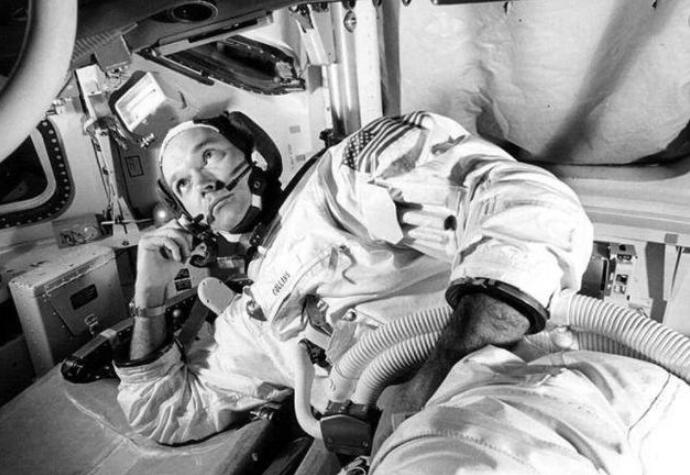Obituary: Michael Collins
訃告:邁克爾·柯林斯
The third man
第三人
Michael Collins, astronaut, died on April 28th, aged 90
宇航員邁克爾·柯林斯,于4月28日離世,享年90歲
The moon that filled the window of the spacecraft Columbia was not one Michael Collins had ever seen before. It was absolutely three-dimensional, its belly bulging out towards him. Cascading sunlight formed a halo round it. The lighter parts were a lot lighter than usual, the jagged mountains darker. It was electrifying. Then the feeling passed. “Hello Moon!” he quipped. “How’s the old backside?”
邁克爾·柯林斯(Michael Collins)從沒見過這般景象:“哥倫比亞號”指揮艙窗外被月亮填滿,如此立體、圓鼓鼓地凸向他。日光照射在月亮周圍形成光暈,亮處比平常要亮很多,參差不齊的山脈稍顯暗沉。這樣的情景令他振奮,這樣的感覺稍縱即逝。“月亮你好呀!”他打趣道,“你那邊的屁股還好嗎?”
This was the closest he had come, as the Apollo 11 crew on July 19th 1969 scouted out their best landing place. But he knew all about the Moon: dry, lifeless, rough as a corncob. Sometimes it looked like a sun-seared peach pit, sometimes like smallpox. What it never looked was interesting. He would certainly much rather have flown off to Mars.
這是他距月球最近的一次。1969年7月19日,阿波羅11號機(jī)組人員到處尋找最佳著陸點(diǎn)。他早就對月球了如指掌:氣候干燥、了無生氣,表面坑洼的像根玉米棒。有時,月面看起來像曬干的桃核,有時又像天花。總之從來沒有呈現(xiàn)過有趣的樣子。相比而言,他更希望飛到火星。

It was therefore no hardship, when his colleagues Neil Armstrong and Buzz Aldrin took the lunar module Eagle down to the surface and clumped about on it, for him to stay for 27 hours in orbit in Columbia. Someone had to get them home. Besides, he loved Columbia, finest of ships, commodious and a friend. It pained him to think of Neil and Buzz trailing their grimy moon-goo into it. On his previous spaceflight, the Gemini 10 mission with John Young in 1966 to practise manoeuvering in Earth orbit, the two of them had squashed into a cabin the size of the front seat of a Volkswagen. By contrast Columbia almost reminded him, if you took the centre couch out, of Washington National Cathedral. When he later became director of the new National Air and Space Museum, planning and completing it on time and under budget, she had a place of honour, right by Lindbergh’s Spirit of St Louis.
所以,當(dāng)同事尼爾·阿姆斯特朗(Neil Armstrong)和巴茲·奧爾德林(Buzz Aldrin)將“鷹”號登月艙降落在月球表面、費(fèi)勁力氣踏上月球時,“哥倫比亞”號指揮艙的柯林斯在飛船軌道停留了27個小時,這于他而言并非難事。總要有人把登月者接回家。柯林斯喜歡也最愛“哥倫比亞號”,她寬敞舒適,像他的好朋友。一想到尼爾和巴茲會把臟兮兮的月球粘土帶進(jìn)船艙,他就難過不已。在此前的1966年,他和約翰·楊(John Young)一起操縱雙子座10號執(zhí)行地球軌道飛行任務(wù)時,兩人擠在大眾汽車前座大小的機(jī)艙中,相比之下,如果撤走航天座椅,他甚至覺得“哥倫比亞號”寬敞如華盛頓國家大教堂。后來,柯林斯擔(dān)任國家航空航天博物館的館長,負(fù)責(zé)規(guī)劃部署,按時按預(yù)算完成了場館的建設(shè),他讓“哥倫比亞號”光榮地坐落在林德伯格的“圣路易斯精神號”身邊。
Ensconced in Columbia he could dine in splendour on tubes of his favourite cream-of-chicken soup, drink fairly hot coffee, listen to music and crank up the thermostat to 76 degrees. For 48 minutes in each of 14 orbits, as he passed the Moon’s meteor-battered backside, it was a joy to get Mission Control to shut up for a while. So when the press called him the loneliest man in history, or at least since Adam, 65 miles above his comrades, 250,000 miles from home, that was ridiculous. Occasionally forgotten, perhaps.
在“哥倫比亞號”里坐定后,他可以美美地享用雞肉奶油湯,喝點(diǎn)熱咖啡,聽聽音樂,把恒溫器調(diào)高到24.4度。每飛行48分鐘,他就變換到14條軌道的其中一條,經(jīng)過被隕石撞擊的月球背面時,他會暫時關(guān)閉任務(wù)控制系統(tǒng),靜靜地享受這段時間。所以,當(dāng)媒體稱他為史上最孤獨(dú)的人時(或者至少自亞當(dāng)以來),想想他正處于同事頭頂65英里、距家25萬英里,多么不可思議。只是,有時候他也許會被遺忘。
譯文由可可原創(chuàng),僅供學(xué)習(xí)交流使用,未經(jīng)許可請勿轉(zhuǎn)載。











